
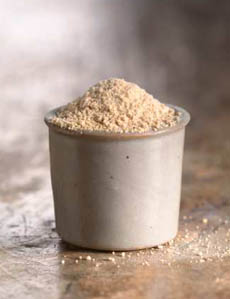 Maple sugar is maple syrup in a granulated form. Photo courtesy King Arthur Flour. Maple sugar is maple syrup in a granulated form. Photo courtesy King Arthur Flour.
November 2006
Last Updated December 2013
|
 |
Different Kinds Of Sugar: A Glossary Of Sugar & Syrup Types
Page 4: Icing Sugar & Other Terms From H To M
This is Page 4 of a seven-page glossary of different kinds of sugar. Click on the black links below to visit other pages. See all of our delicious food glossaries.
This material is copyrighted and cannot be reproduced in whole or in part.
You are welcome to link to it.
HIGH FRUCTOSE CORN SYRUP (HFCS)
A sweeter form of corn syrup made from corn starch in a process developed in the 1970s and introduced widely into American processed foods in the 1980s, 20% cheaper and easier to transport than sugar. It is used by manufacturers as a substitute for ordinary sugar (sucrose) in soft drinks and other consumer goods—yogurt, frozen foods and foods where you don’t expect to find sweeteners, such as bread, pasta sauce and soup. HFCS in beverages seems to have the effect of stimulating the appetite. This, coupled with the pure caloric content of beverages sweetened with HFCS, and the preference of children and adults for soft drinks over nutritious beverages (milk, juice), is thought to be a cause of increased levels of obesity in America. The widescale introduction into the food supply parallels increased obesity in America; HFCS may not be to blame in and of itself, as much as the trend of manufacturers packing more sweetener into foods instead of more expensive ingredients like herbs, and Americans buying more processed foods filled with hidden sweeteners.
|
(The American palate has become “sweetened” by this process: Whereas in the 1960s, sugar was largely confined to confections and desserts, it is now ubiquitous in almost every food product and recipe because Americans are accustomed to having everything, from salad dressing to meat sauces, taste sweet.) Scientists say that sugar and HFCS are equally harmful when consumed in excess, and according to an extensive article in The New york Times (March 21, 2009, p. A1), the argument is “as much about marketing as it is about science.” Although white sugar is a highly refined product (see table sugar and raw sugar), it is less processed than HFCS, which is produced by a complex series of chemical reactions that includes three enzymes and caustic soda.
|
|
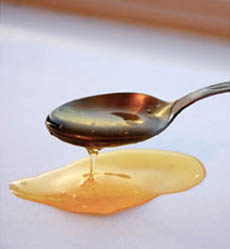
High fructose corn syrup. Photo courtesy WakeMedVoices.org. |
|
HONEY
Unlike the other syrups on this list, honey is a pure, natural product to which nothing is added; but it meets the definition of a syrup. A sweet and viscous fluid produced by bees and other insects from the nectar of flowers, it can be used in the same cooking, baking, and flavoring applications as other syrups. Its flavor is influenced by the type of plant tapped by the bee (clover, orange blossom, sage etc). Honey consists of equal parts of sucrose and fructose, plus trace minerals and pollen. It is 25% to 50% sweeter than sugar. Along with maple syrup, it is an almost completely unrefined product. See the different types of honey.
|
|
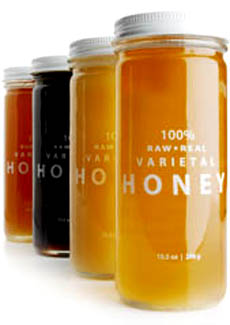
Raw American varietal honeys from BeeRaw.com. |
ICING SUGAR
Another term for confectioners’ sugar. See photo at top of page.
|
INVERT SUGAR or INVERTED SUGAR SYRUP
Invert sugar is a sucrose-based syrup that is made by splitting sucrose into glucose and fructose. It is treated with the enzyme invertase and/or an acid, giving it a more rounded sweetness and preventing crystallization. It is sweeter than sucrose (table sugar), less prone to crystallization and helps products to retain moisture. It is therefore popular in commercial baked goods, where it is also called trimoline. Golden syrup has undergone a partial inversion; it is approximately 56% invert syrup, 44% sucrose. Honey is a mixture of primarily glucose and fructose, giving it similar properties to invert syrup. In the process of making jam, the extensive heating of the the fruit acids produces invert sugar.
|
|
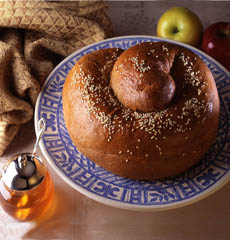
Challah and other sweet baked goods can be made with invert sugar. Photo courtesy National Honey Board. |
|
JAGGERY or PALM SUGAR or
COCONUT PALM SUGAR or GUR
An unrefined brown sugar made from sap or the nectar of the flowers of the coconut palm tree (jaggery is also made from sugar cane—details). The juice is kettle-boiled over an open hearth fire; the nectar slowly evaporates into a caramel-like sugar which thickens to a buttery paste and is ladled into coconut shell molds to cool and set. Jaggery has a distinctive sweet, winey fragrance and flavor. Popular in India, it comes in several forms, the most popular being a soft, honey-colored, buttery texture used as a spread and a solid tan cakelike form that crumbles, used to sweeten cereal and other foods. Or, by grinding the traditional sugars and applying dry heat, a fine-ground palm sugar that can be used in place of any fine sugar.
|
|
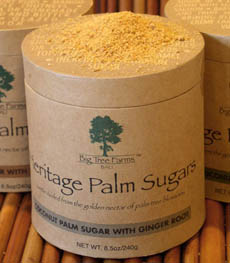
Palm sugar available at iGourmet.com. |
JAVA SUGAR
See coconut sugar and jaggery, above.
KARO SYRUP
A brand of dark corn syrup.
|
LEMON SUGAR, LIME SUGAR or
ORANGE SUGAR
Flavored sugar made by mixing citrus zest, peel or juice with granulated sugar or a mix of granulated and confectioner’s sugar. The flavored sugar is used instead of plain granulated sugar in tea and in baking, and as a drink rimmer for the Lemon Drop and other cocktails and beverages.
MALTOSE or MALT SUGAR
Not a consumer product, it plays a role in the fermentation of alcohol by converting starch to sugar.
MAPLE SUGAR
Dried and granulated maple syrup. Used on cereal, toast, yogurt, pudding and ice cream. See photo at top of page.
|
|
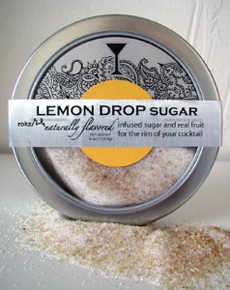
Lemon-flavored sugar. You can buy it online. Photo courtesy Rokz | Amazon. |
|
MAPLE SYRUP
A largely unrefined sweetener made from the sap of maple trees, maple syrup is the boiled sap of the sugar maple tree. It is about 62% sucrose, and is about 60% as sweet as sugar. It is the preferred condiment with pancakes and waffles; a popular glaze for ham, pork, duck and vegetables; and a flavoring in candy and desserts. It can enhance anything from sweet potatoes to martinis. There are many artificially-flavored imitators of the real thing. See our article on the different grades of maple syrup.
|
|
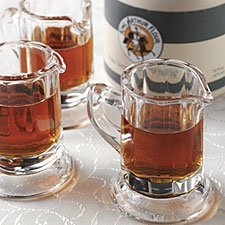
Maple syrup. Photo courtesy King Arthur Flour. |
MAPLE SYRUP SUGAR
Made by boiling the tree sap until the liquid has evaporated and the crystals remain, maple sugar is more concentrated and twice as sweet as white sugar. It is a largely unrefined sugar, since it is only boiled tree sap.
|
MOLASSES OR TREACLE
A thick syrup produced as a by-product during the refining of sugar cane,* molasses is the residue that is left after the sugar crystals are extracted (i.e., molasses is produced when no more sugar may be economically crystallized by conventional means). About 80% of the world’s molasses comes from sugar cane, with the remaining 20% coming mainly from sugar beets. The better grades, such as New Orleans drip molasses and Barbados molasses, are unreprocessed and contain more sucrose, making them lighter in color; they are used in cooking and confectionery and in the production of rum.
- Light molasses comes from the first boiling of the cane. It is also called sweet molasses and is used as pancake syrup or a sweetener.
- Dark molasses comes from the second boiling. It is more flavorful and less sweet than light molasses, and often used for gingerbread and spice cookies.
|
|
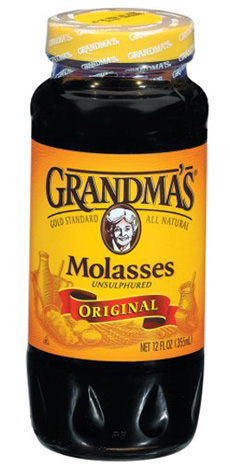
Molasses. Photo courtesy Grandma’s. |
- Blackstrap molasses, the lowest grade, comes from the third boiling; it is strong and bitter, and mainly used in mixed cattle feed and in the manufacture of industrial alcohol. Sulfured molasses, has had sulfur dioxide added as a preservative (or, the sulfur in the manufacturing process is retained in the molasses). Treacle is the British term for dark molasses; light molasses is called golden syrup. Molasses is predominantly sucrose, with some glucose and fructose. It is 65% as sweet as sugar.
*Food-grade molasses is made from sugar cane; sugar beet molasses is too bitter.
MOLASSES SUGAR
A specialty soft brown sugar made of natural cane molasses. It has the deepest color and richest flavor of all sugars, and is used in recipes for barbecue, Christmas and dark chocolate cakes, ethnic dishes, marinades and mincemeat.
MUSCOVADO SUGAR or DARK MUSCOVADO SUGAR or MOIST SUGAR or
BARBADOS SUGAR
|
A specialty raw sugar, moist with a high molasses content and a strong molasses flavor. As with brown sugar, there are light and dark brown versions. The dark brown variety is very dark in color, and slightly coarser and stickier than most brown sugars. Popular in cookies, gingerbread and chocolate cake. Unrefined dark muscovado is the world’s finest dark brown soft sugar. Its rich taste and natural color add depth to cooking and baking. It is often used in fruit and chocolate cake recipes, marinades, savory sauces and chutneys. Originally an export of the Philippines, muscovado takes its flavor and color from the sugar cane juice it is made from. It also is made into a light muscovado variety for biscuits, cakes, savory dishes and toffee sauce.
|
|
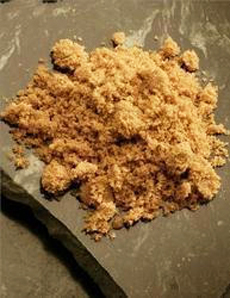
Light brown muscovado sugar, available from Alibaba.com. |
Continue To Page 5: Terms Beginning With N To R
Go To The Article Index Above

|












